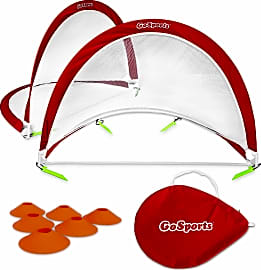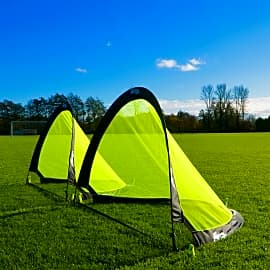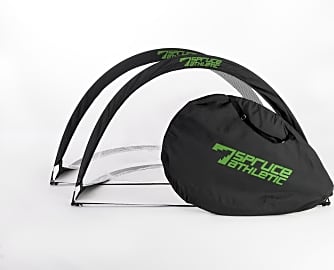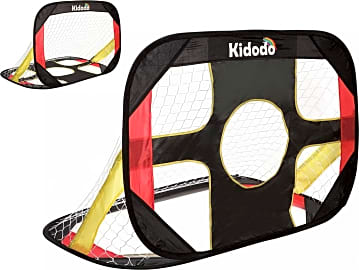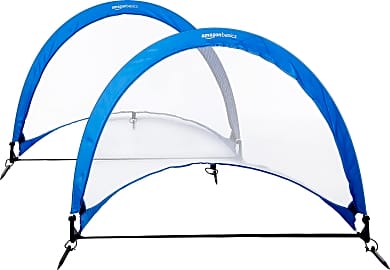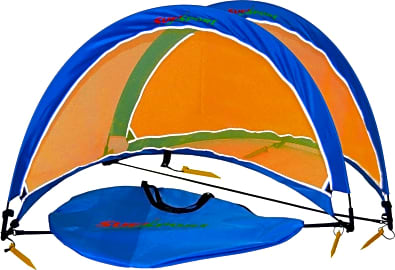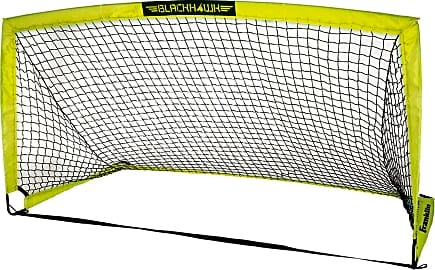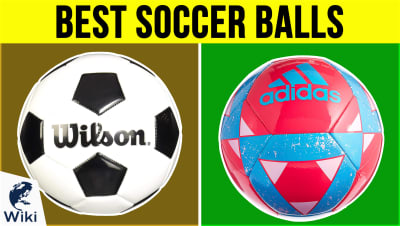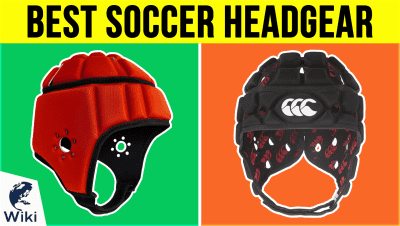The 10 Best Popup Soccer Goals

This wiki has been updated 41 times since it was first published in January of 2016. Treat the budding soccer player in your family to one of these pop-up goals, which are ideal for practicing in the backyard, and are portable and light enough for your kids to carry them on their own to the park for a pickup game. They’re easy to fold up for storage, and many come with a durable, weather-resistant construction that allows them to hold up for years of use. When users buy our independently chosen editorial choices, we may earn commissions to help fund the Wiki.
Editor's Notes
May 21, 2020:
When you’ve got kids in soccer, a couple of these popup soccer goals are a must for convenient practice in the yard or at the park. They fold up compactly so as to fit nicely in a backpack along with a soccer ball and a pair of cleats. Their portable nature enables you to take them anywhere with ease, and many come in bright colors that are easy to spot from across the field, as well as reflective piping so you won’t need to end practice or your game just because the sun is going down. One such highly visible model is the newly added Forza Flash, which come as a set of two, and are made of weatherproof materials and hard-wearing mesh nets. Their stakes measure 8 inches in length, which is longer than those of some other models, so they’ll stay securely anchored into the ground. They’re available in three sizes, so you’re sure to find the right one for players of all ages. We also added in the AmazonBasics Training, another set of two. They come at an affordable price and are easy to set up and fold down. The nets are sturdy, yet you should know the stakes are only designed for use with soft ground.
For kids looking to improve their aim and get in some corner shots, look to the Kidodo Portable, which incorporates five target holes on a panel that can be removed completely for regular goal shooting. It’s constructed of durable steel and polyester and is suitable for either indoor or outdoor use. In the case of these nets, it’s hard to beat the original of their kind, which is the Pugg PS1, so we left it in the number one spot. It’s available in sets of one or two, and comes with a carrying bag and a spare parts kit. It folds down compactly to a one-inch flat oval, and its rugged steel construction can stand up to an intense level of play. Another noteworthy model is the Golme Pro, which is available in three sizes for players of all ages, and it too holds up well over time. Its reflective band allows you to keep playing when dusk arrives. It comes with a zippered carrying pouch and is backed by a one-year warranty.
In this update, we removed the Franklin Junior, a smaller choice that’s suitable for small kids, but as many have noted, it doesn’t hold up well over time. We also removed the Trailblaze Fluorescent Green to make room for a set that’s more readily available.
Special Honors
Brava 6-Foot Pop Up Goal These foldable goals are great for quick pick-up games at the park, thanks to their easy setup and breakdown process. Included are two goals, metal stakes, and a convenient, sturdy carrying bag. Their neon green color makes them easy to spot from across a field. academy.com
A Brief History Of Soccer
Prior to these rules, there was little distinguishing soccer from rugby.
The earliest known soccer-like activity dates back to the Chinese Han Dynasty around 200 B.C.E. People would play a game called "cuju," which literally translates to "kick ball," in which players could use any part of their body except their hands to force a ball through a hole in a net. Sound familiar?
The Greeks had their own spin on things, with multiple ball games, and all they really had in common was violence. In most of their games, using hands was allowed, and all that mattered was that somebody got hurt. Similar activities eventually cropped up in Japan, Korea, and (of course) Australia.
Kick-ball games existed in England as early as the 8th century C.E., but they really took off after the Cambridge Rules were adopted in 1848. Around that same time, several soccer clubs began cropping up, usually affiliated with a school or university of some sort.
Prior to these rules, there was little distinguishing soccer from rugby. These regulations established everything from the off-sides rule to the banning of tripping. Using your hands was largely forbidden, except you were allowed to catch a ball in mid-air and then kick it without running.
In 1863, The Football Association was founded in London. This organization established the first known soccer competition, called the FA Cup, which is still contested in England today.
All of the organizing bodies in Great Britain formed the International Football Association Board in 1886, which became the regulatory commission tasked with creating the laws of the game. A similar, international governing body, FIFA, was born in 1904.
These codified regulations would become very important in the growth of the game. Matches regularly drew tens of thousands of spectators in England, and as British subjects traveled the world they took the game with them. Since there were clearly-defined, universal rules, the game spread easily and was capable of traversing borders without issue.
A big reason for the enduring popularity of the game is that it's fairly simple, so you can quickly learn how to play, or appreciate watching others. In addition, it's an inexpensive sport, as all you need is a ball, something that functions as a goal, and a large, open pitch.
The Olympics added a soccer competition in 1908, and it would be the most prestigious title in the sports until FIFA established the World Cup in 1930.
Today, the World Cup is the biggest sporting event in the world, as virtually every country grinds to a halt every four years to see who will be crowned champion. Soccer is the most-played sport around the globe, and its' popularity only figures to continue growing in the years to come.
Who knows — if the game lives on long enough, America might even win the World Cup someday.
Advantages Of A Pop-Up Goal
While you don't need much in the way of equipment to get a match going, it's hard to have a real game if you don't have a goal of some sort — and while kicking the ball between a trash can and a large rock technically works, it lacks a certain je nais sais quoi.
Pop-up goals can go a long way towards solving this problem. They're not suitable for a full-blown game between adults, but they're great for kids or a backyard contest.
Since they collapse when not in use, you can keep one in the trunk of your car, and you'll always be prepared without having to sacrifice much cargo space.
One of their main advantages is how convenient they are to lug around. Since they collapse when not in use, you can keep one in the trunk of your car, and you'll always be prepared without having to sacrifice much cargo space. Similarly, you can store one in your garage, and you'll barely notice it's there.
They're also fantastic for drills and practice. You can work on your aim virtually anywhere, or you can use it to coach your youth team as they learn the fundamentals.
Perhaps the most important benefit, however, is they allow you to be able to get a game going anywhere, at anytime. A simple day at the park or family BBQ can quickly transform into a fun match, or you can just have something entertaining to do if you have some time to kill. All you need is a goal and a pair of cleats, and you're ready for fun.
Of course, you could just try to rig up a low-budget alternative using your car and Grandma once she falls asleep, but ask yourself: do you really want to risk your car's health over a game of soccer?
Benefits of Playing Soccer
Soccer is undeniably fun — so much so, in fact, that you likely won't even realize how fantastic it is for you. Before we list the benefits, however, we have to give the standard warning to consult your doctor before deciding to become the next Messi, and be sure to use the proper protective gear while playing.
Getting together with friends can help build self-esteem, battle depression, and reduce anxiety.
The cardiovascular benefits are clear, as you need to be in good shape to be able to chase a ball around the pitch for an hour and a half. The average player runs about seven miles per game, so if you plan to participate the entire time, you'll need to have good stamina.
All of that starting, stopping, and turning on a dime is great for burning fat and building muscle tone, as well. You use a combination of both slow- and fast-twitch muscle fibers during a game, which helps you build mass and shred fat cells. Your body is constantly switching between aerobic and anaerobic pathways, giving you a workout similar to a HIIT routine.
The benefits aren't all physical, however. Getting together with friends can help build self-esteem, battle depression, and reduce anxiety. Plus, young athletes learn the importance of teamwork and sharing, which can directly translate into success off the pitch.



